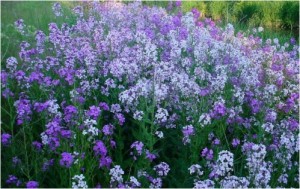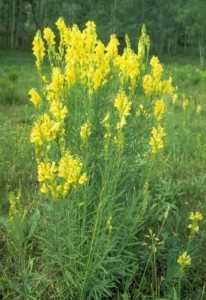GROWING WILD: A ‘HOW-TO’ GUIDE
FOR AVOIDING WEED-FILLED WILDFLOWER MIXES
| Printable Version |
By Greta Gramig, Ph.D., a member of the Weed Science Society of America
Wildflower mixes offer a quick and easy way to create vibrant meadows of colorful blooms – providing long-lasting beauty and a habitat for birds and butterflies. If you plant the wrong mix, though, you could end up with invasive or weedy plants as unintended guests in your garden or natural area.
One example: A wildflower mix was the source of an Oregon infestation of Paterson’s curse (Echium plantagineum), an exotic noxious weed native to the Mediterranean. This drought-tolerant plant is poisonous to grazing animals and can produce skin irritation and hay fever in humans.
University of Washington researchers shed light on the problem of weeds in wildflower mixes, examining 19 seed packets to see what lurked inside. Almost half contained seeds of plants considered noxious weeds in at least one U.S. state or Canadian province, such as dame’s rocket (Hesperis matronalis), oxeye daisy (Leucanthemum vulgare), Queen Anne’s lace (Daucus carota) and yellow toadflax (Linaria vulgaris).
In addition to noxious weeds, all the wildflower seed mixes in the study contained plants that can grow invasively under the right conditions. One example is common yarrow (Achillea millefolium), an aggressive grower that spreads through rhizomes and can crowd out desired species.
Even some of the ornamentals found in wildflower mixes can wreak havoc if they escape into the wild from their desired location. For example, bachelor’s buttons (Centaurea cyanus) is a prolifically blooming annual found in many wildflower mixes. Though well-behaved in most home gardens, bachelor’s buttons can aggressively out-compete native plants in a natural area. The same is true of the California poppy (Eschscholzia californica), another frequent favorite in mixed wildflower seed packets.
What can you do to keep noxious weeds and other invasive plants out of your wildflower garden and natural areas? First and foremost, be careful about what seeds you buy. Here are a few tips that can help:
- Purchase high-quality, local seeds tested for purity so that any stray weed seeds are less likely to be devastating exotic imports like Paterson’s curse.
- Buy mixes with wildflowers native to your region and double-check the seeds included. Otherwise, you could find yourself with plants that behave aggressively or invasively in your region.
- Avoid mixes with bachelor’s buttons, common yarrow and other aggressively growing ornamentals, such as bird’s foot trefoil (Lotus corniculatus), common tansy (Tanacetum vulgare), cow cockle (Vaccaria hispanica), creeping bellflower (Campanula rapunculoides), evening primrose (Oenothera spp.), purple loosestrife (Lythrum salicaria) and white cockle (Silene latifolia).
- Look for packages clearly labeled with the scientific names of the species included. If only common names are given, confusion can arise. For instance, annual baby’s breath (Gypsophila elegans) is not considered invasive. But perennial baby’s breath (Gypsophila paniculata) is invasive and classified as a noxious weed in both California and Washington.
The best approach of all is to avoid mixes and select specific individual wildflower species based on desired characteristics. You will still have a nice display of wildflowers to add color and interest to your landscape, but with less risk of spreading weeds.
This column is provided as a courtesy by the Weed Science Society of America (WSSA). The author, Greta Gramig, is an assistant professor of weed ecology in the Department of Plant Sciences at North Dakota State University.
Two examples of noxious weeds found by researchers in wildflower mixes are shown below:

Dame’s rocket. Photo courtesy of Richard Old, XID Services, Inc., Bugwood.org
|

Yellow toadflax. Photo courtesy of L.L. Berry, Bugwood.org.
|















